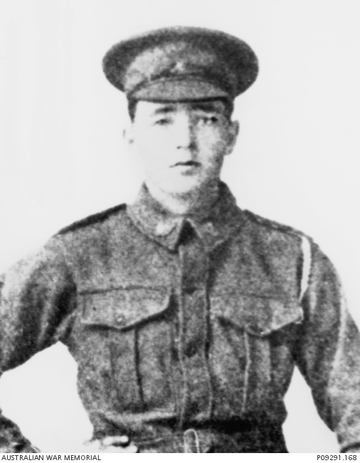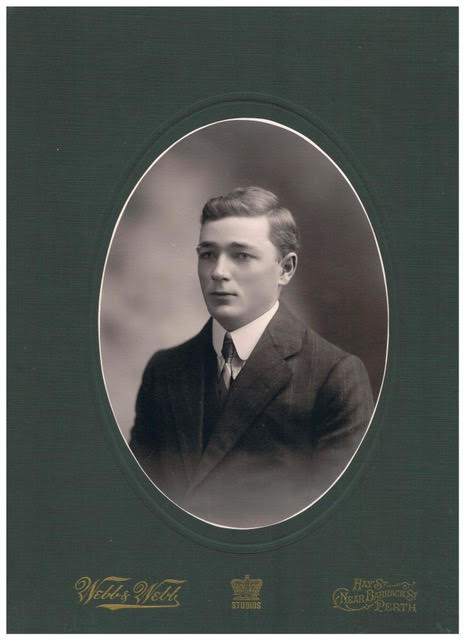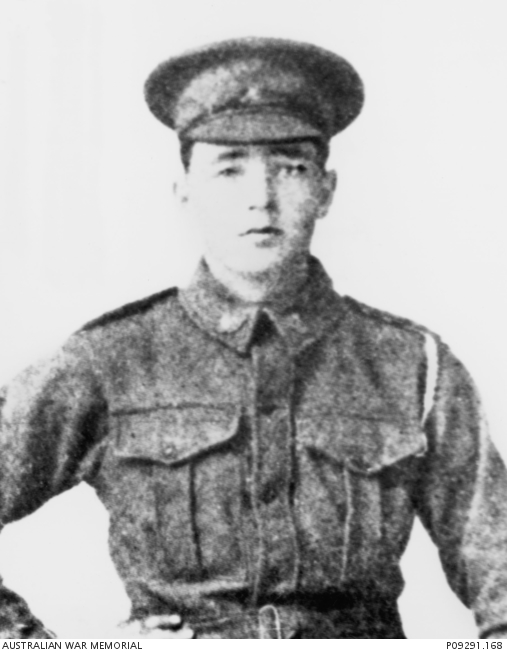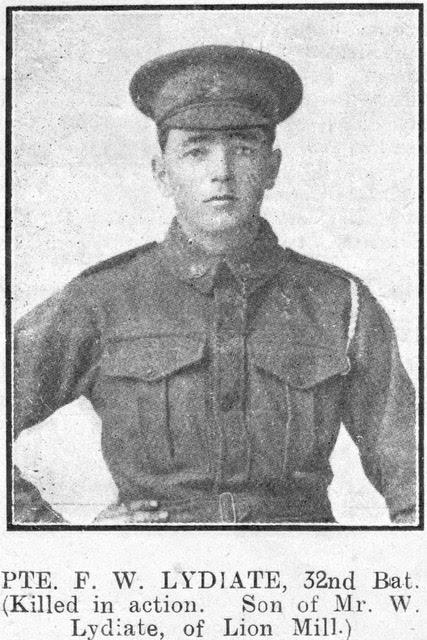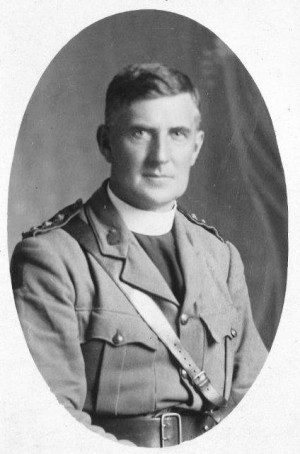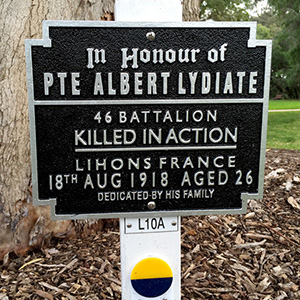Frederick William LYDIATE
Eyes blue, Hair brown, Complexion fair
The Lydiate Family
This story was largely written from material posted on the FaceBook page, In Search of Charles Albert Stokes DCM, 21 November 2021. We thank Bill Lydiate and Geoff Tilley for their contribution.
Frederick William Lydiate, known as Fred, was born in 1887 in Guildford, WA, the third child of William and Sarah Ann (nee Scrivener). William, a horse driver and teamster (probably in the timber industry), and Sarah married in 1884 and had nine children over the ensuing eighteen years – Hubert, George, Fred, Amy, Ethel, Albert, Eunice, Sydney and William.
Fred was well liked and best man at a number of family weddings. Prior to the war, he shared a house with his sister Ethel in Maylands, near Fremantle and worked as a foreman machinist with Massey-Harris in Perth.
Before the Great War, tragedy had already struck the Lydiate family with the death of two family members. In 1900, at the age of just 15, Fred’s oldest brother, Hubert 1885-1900, was killed by a falling log. In 1912, Fred’s mother Sarah passed away at the age of 47. The war would claim two more family members.
A family at war
As Fred’s father noted on the Roll of Honour circulars completed after the war, Fred ‘was one of four brothers on active service’. The fifth surviving son, William 1903-85, was too young to enlist. A brief outline of each of his four sons’ service is set out below.
Fred, aged 28, was the first of the four Lydiate brothers to enlist on 14 July 1915. He joined the 32nd Battalion serving in Egypt and France before being killed in action on 19 July 1916 in the Battle of Fromelles. He has no known grave and is commemorated at V.C. Corner at the Australian Cemetery and Memorial (panel 5).
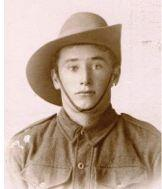
Just weeks after his sixteenth birthday, Sydney Lydiate lied about his age to enlist in February 1916 with the 44th Battalion while his brother Fred was still serving in Egypt. Sydney served in the trenches in France but was shifted to a non-combat role when he was discovered to be underage. His civilian experience as a teamster resulted in him serving with the Australian Army Veterinary Hospital, initially as a farrier and later as staff sergeant. He returned to Australia in August 1919.

Next to enlist was Albert in October 1916, probably already aware that his older brother Fred had been killed in action. Albert sailed from Australia in December 1916. A woodcutter in civilian life, he underwent training in England before falling seriously ill with bronchial pneumonia in April 1917. He took some months to recover before sailing to France where he was taken on strength with the 46th Battalion in September 1917. He took part in a number of battles on the Western Front before being killed in action by shellfire on the night of August 18, 1918 near Lihons in France. He was 26 years of age and is buried in the Fouquescourt British Cemetery (plot 1 row B grave 6) in France.

George, the eldest of the surviving brothers, was a railway employee before enlisting in May 1917, aged 31. He sailed with the 4th Division Signal Company in November 1917 serving briefly in Egypt before going to England where he spent some months in training camp. In October 1918, he embarked for France but only served a few weeks before becoming seriously ill with bronchial pneumonia and was evacuated back to England for treatment. On recovering, George took leave to undertake motor engineering training and eventually returned to Australia in September 1919.
Frederick and the Battle of Fromelles
Fred embarked from Adelaide, South Australia in November 1915 attached to C Company, 32nd Battalion. He disembarked at Suez in December 1915 joining the British Expeditionary Force in Alexandria, Egypt. Whilst there he conducted further training with his Battalion before embarking for France in June 1916. On arrival in France, the Battalion was sent to Morbecque near Hazebrouck.
On 14th July 1916, the 32nd Battalion moved to billets at Fleurbaix in preparation for an assault on the German lines. The British High Command formulated a plan with the intention of attacking the German lines at Fromelles, anticipating that this attack would draw German troops away from the Somme offensive. Part of the plan was directed at a well defended position known as the Sugar Loaf salient. This position encroached into no man’s land putting the German defenders in an advantageous position to cover no man’s land if an assault took place.
The plan was to use the Australian 5th Division (which included 15th, 14th and 8th Brigades) along with the British 61st Division. The 31st and 32nd Battalions, as part of the 8th Brigade, participated in the attack on the extreme left flank of the assault. They had to cover about 100 metres across no man’s land to reach the German trenches. A seven-hour artillery bombardment was to precede the attack which was set to begin at 6pm on 19th July 1916.
Private Frederick Lydiate with men from C Company of 32nd Battalion and 31st Battalion were to form the first and second waves of the attack and were in position in the trenches. Even before the attack commenced, the Australians had already suffered severe casualties from not only the German artillery but also from the inexperienced Australian artillery who lacked the skill to provide cover for the battalions.
With the commencement of the attack, the flank of the 8th Brigade came under further artillery bombardment causing additional casualties and forcing the third and fourth waves of the attack to be combined. This reduced the strength of the Australian attack who, by now, were suffering heavily from the German machine gunners who had recovered from the preliminary artillery bombardment. With continued enfilading German machine gun fire into the Australians, the 32nd and 31st Battalions were able to capture a small section of the German trenches. However, with no follow up support and continued German counter attacks, the Australians were forced to withdraw leaving many of their casualties in the German trenches.
By the morning of 20 July 1916, the attack was over and the Australians had suffered more than 5,000 casualties. For the 32nd Battalion the diary entry for July 1916 [AWM] read, “Officers; killed 4, wounded 8, missing 4. Ordinary ranks; killed 67, wounded 367, missing 214.”
Family at home
It seems that the first news the family received about Fred may have been from William O’Shea who was with Fred when he was killed in action and had written to advise the Lydiate family directly. William had also enlisted at Blackboy Hill and was repatriated back to Australia in December 1916 due to the gunshot wound in his arm that he received at the Battle of Fromelles.

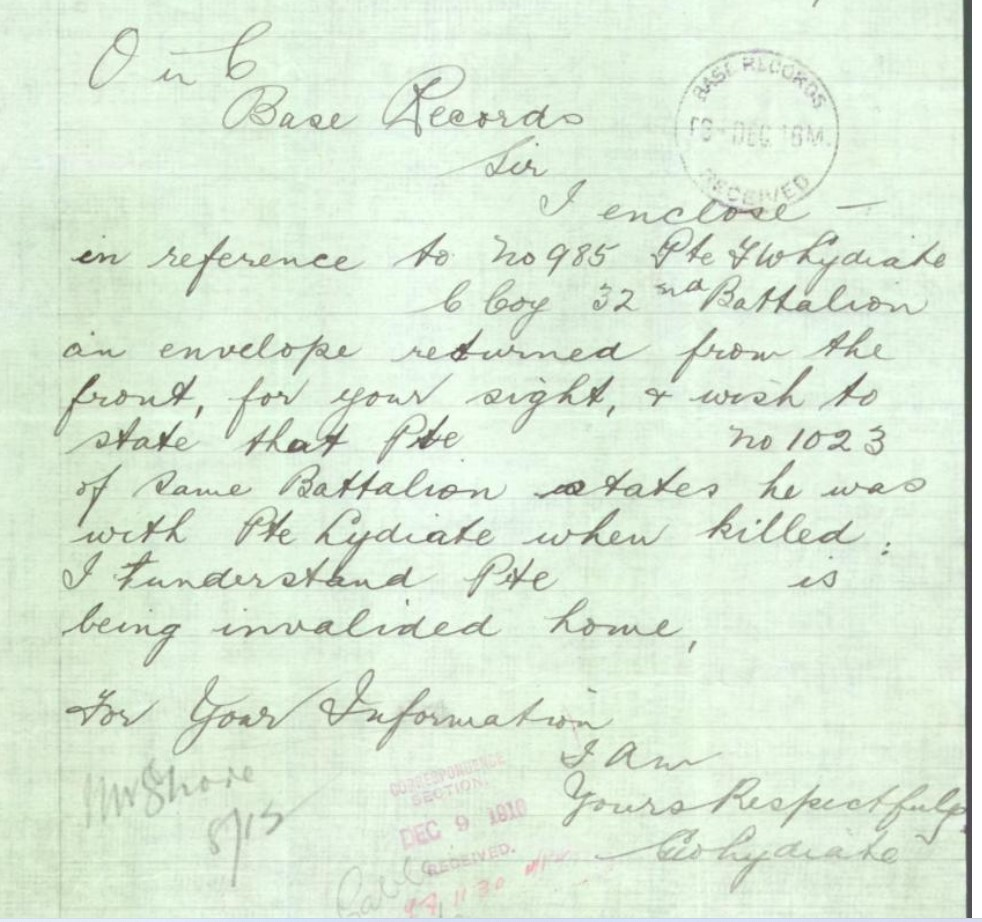
Fred’s Red Cross file gives virtually no information about Fred’s death however the family received confirmation of his death by a letter from the Chaplain Frederick Greenfield Ward, based at the Front.
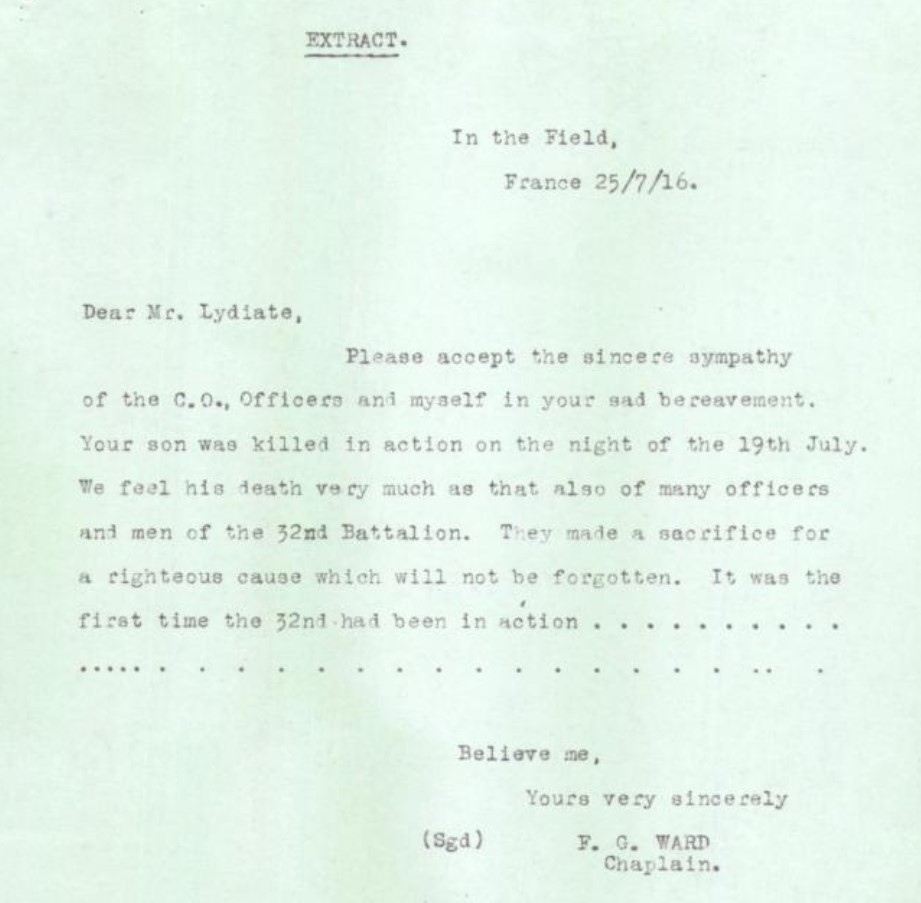
Base Records had no official notification of Frederick’s death at the time and it took some months before official notification was finalised. By December 1916, Frederick was officially listed as killed in action and, in January 1918, Fred’s personal effects were returned to his father – his identity disc, wallet and photos.

The Aftermath
George and Sydney both returned to Western Australia from the war in 1919.
Bill Lydiate recalled that his dad, George, never really spoke about the war and his medals were still in their packets, never touched. He married later in life and had 4 children, passing away in 1965, aged 79.
A few years ago, a cousin of Bill’s found both Fred and Albert’s medals in his father Sydney’s belongings. Uncle Sid also didn’t talk about the war. It seems this was typical at the time - they just go on with it, returned home and got back to work. Losing two brothers however must have been hard. The family posted a number of memorials in newspapers over the years fondly remembering Fred.

Fred is remembered with honour:
- V.C. Corner (Panel No 5), Australian Cemetery and Memorial, Fromelles, France
- Australian War Memorial Roll of Honour, Canberra, ACT
- Guildford Methodist Church and Sunday School Roll of Honour, Guildford, Swan, WA
- Kings Park Honour Avenue, Kings Park, Perth, WA
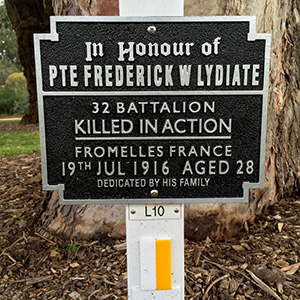
DNA donors are still being sought for family connections to
| Soldier | Frederick William LYDIATE 1887-1916 |
| Parents | William LYDIATE b 1859 Victoria, d 1921 Western Australia | ||
| and Sarah Ann SCRIVENER 1864-1912 Western Australia |
| Grandparents | |||
| Paternal | William LYDIATE 1811-1868 and Sophie LEAVER 1823-1874 | ||
| Maternal | Richard SCRIVENER b 1825 England d 1908 WA and Elizabeth FINCH b 1828 England d 1866 WA. |
Links to Official Records
Seeking DNA Donors

Contacts
(Contact: royce@fromelles.info or geoffrey@fromelles.info).
(Contact: army.uwc@defence.gov.au or phone 1800 019 090).
Donations
If you are able, please contribute to the upkeep of this resource.
(Contact: bill@fromelles.info ).
